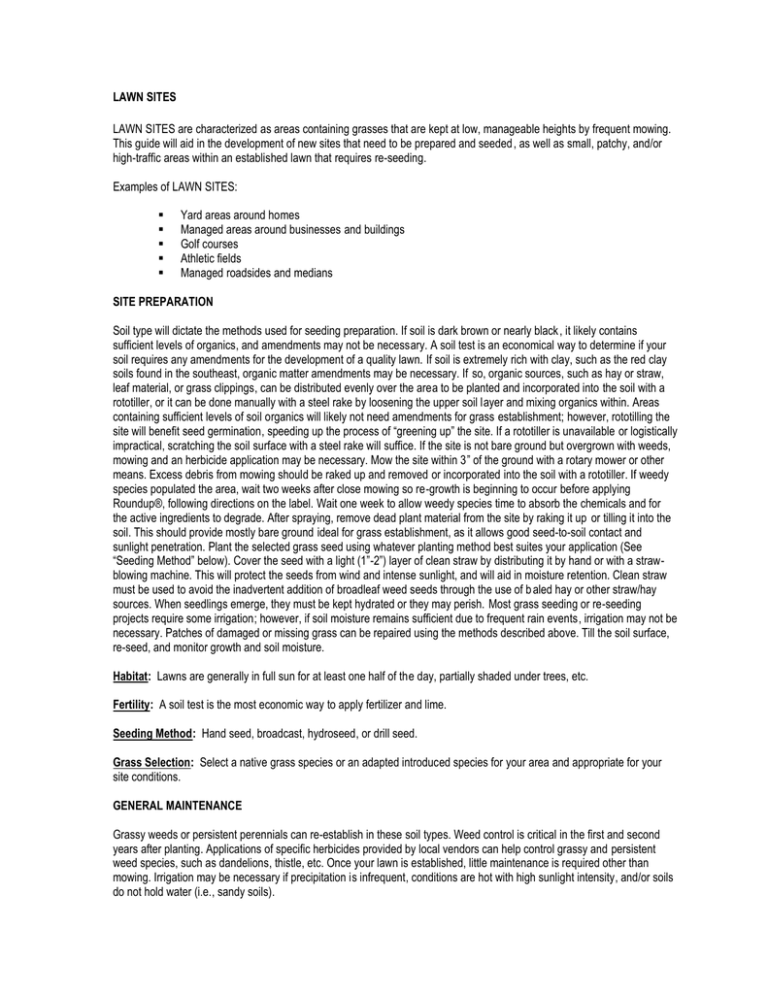LAWN SITES LAWN SITES are characterized as areas containing
advertisement

LAWN SITES LAWN SITES are characterized as areas containing grasses that are kept at low, manageable heights by frequent mowing. This guide will aid in the development of new sites that need to be prepared and seeded, as well as small, patchy, and/or high-traffic areas within an established lawn that requires re-seeding. Examples of LAWN SITES: Yard areas around homes Managed areas around businesses and buildings Golf courses Athletic fields Managed roadsides and medians SITE PREPARATION Soil type will dictate the methods used for seeding preparation. If soil is dark brown or nearly black , it likely contains sufficient levels of organics, and amendments may not be necessary. A soil test is an economical way to determine if your soil requires any amendments for the development of a quality lawn. If soil is extremely rich with clay, such as the red clay soils found in the southeast, organic matter amendments may be necessary. If so, organic sources, such as hay or straw, leaf material, or grass clippings, can be distributed evenly over the area to be planted and incorporated into the soil with a rototiller, or it can be done manually with a steel rake by loosening the upper soil layer and mixing organics within. Areas containing sufficient levels of soil organics will likely not need amendments for grass establishment; however, rototilling the site will benefit seed germination, speeding up the process of “greening up” the site. If a rototiller is unavailable or logistically impractical, scratching the soil surface with a steel rake will suffice. If the site is not bare ground but overgrown with weeds, mowing and an herbicide application may be necessary. Mow the site within 3” of the ground with a rotary mower or other means. Excess debris from mowing should be raked up and removed or incorporated into the soil with a rototiller. If weedy species populated the area, wait two weeks after close mowing so re-growth is beginning to occur before applying Roundup®, following directions on the label. Wait one week to allow weedy species time to absorb the chemicals and for the active ingredients to degrade. After spraying, remove dead plant material from the site by raking it up or tilling it into the soil. This should provide mostly bare ground ideal for grass establishment, as it allows good seed-to-soil contact and sunlight penetration. Plant the selected grass seed using whatever planting method best suites your application (See “Seeding Method” below). Cover the seed with a light (1”-2”) layer of clean straw by distributing it by hand or with a strawblowing machine. This will protect the seeds from wind and intense sunlight, and will aid in moisture retention. Clean straw must be used to avoid the inadvertent addition of broadleaf weed seeds through the use of b aled hay or other straw/hay sources. When seedlings emerge, they must be kept hydrated or they may perish. Most grass seeding or re-seeding projects require some irrigation; however, if soil moisture remains sufficient due to frequent rain events, irrigation may not be necessary. Patches of damaged or missing grass can be repaired using the methods described above. Till the soil surface, re-seed, and monitor growth and soil moisture. Habitat: Lawns are generally in full sun for at least one half of the day, partially shaded under trees, etc. Fertility: A soil test is the most economic way to apply fertilizer and lime. Seeding Method: Hand seed, broadcast, hydroseed, or drill seed. Grass Selection: Select a native grass species or an adapted introduced species for your area and appropriate for your site conditions. GENERAL MAINTENANCE Grassy weeds or persistent perennials can re-establish in these soil types. Weed control is critical in the first and second years after planting. Applications of specific herbicides provided by local vendors can help control grassy and persistent weed species, such as dandelions, thistle, etc. Once your lawn is established, little maintenance is required other than mowing. Irrigation may be necessary if precipitation is infrequent, conditions are hot with high sunlight intensity, and/or soils do not hold water (i.e., sandy soils).


